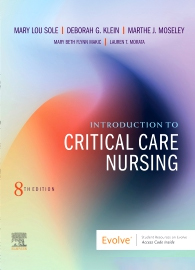
Pages: 664
Publisher: Elsevier
Year of Publication: 2020
Author(s) : Mary Lou Sole Deborah Klein Marthe Moseley
Book Description:
Start here to master the concepts, technology, and procedures of critical care nursing! Introduction to Critical Care Nursing, 8th Edition prepares you to provide safe, effective, patient-centered care in a variety of high-acuity, progressive, and critical care settings. Evidence-based coverage includes realistic case studies and incorporates the latest advances in critical care. Disorders are conveniently organized by body system or special situation, and nursing management chapters include quick-reference nursing care plans. This clear, concise textbook will help you develop the knowledge and clinical reasoning skills needed for success in today's highly complex critical care environments.
Key Features
• Critical Reasoning Activities are included throughout the text, promoting development of clinical nursing judgment to help you prepare for the Next-Generation NCLEX-RN® Exam.
• Emphasis on QSEN competencies enables you to gain the knowledge, skills, and attitudes needed to provide safe, high-quality health care in a variety of high acuity, progressive, and critical care settings.
• Evidence-Based Practice boxes illustrate how research evidence is used to address problems in patient care and includes nursing implications plus AACN’s new system for Levels of Evidence: A, B, C, D, E, and M.
• Universal Collaborative Plan of Care for the Critically Ill Patient addresses key aspects of collaborative/interprofessional care that apply to virtually all critically ill patients.
• Individual Plans of Care prepare you for clinical practice by describing patient problems, patient outcomes, and nursing assessments and interventions with rationales.
• Case studies challenge you to apply concepts to the real world, testing your clinical nursing judgment by asking questions about patient-specific cases with lab results.
• Clinical Alerts highlight potential problems and concerns to improve patient safety and clinical care.
• Laboratory Alerts emphasize the importance of laboratory test results to critical care nursing.
• Medication tables show the actions/usages, indications, dosages/routes, side effects, and nursing implications of medications commonly used in critical care settings.
• Coverage of cardiac assistive devices includes the ECMO device for extracorporeal life support, as well as other small, portable, bedside cardiac-assistive devices.
• Hemodynamic monitoring content now emphasizes the noninvasive methods of hemodynamic monitoring that are becoming more prominent.
• Coverage of infection control addresses the QSEN safety competency and helps provide patient protection against the growing threat of drug-resistant infections.
• Nearly 300 full-color photographs and drawings visually clarify key concepts and equipment for better understanding of today’s complex critical care environment.
https://www.elsevier.com/books/introduction-to-critical-care-nursing/sole/978-0-323-64193-7